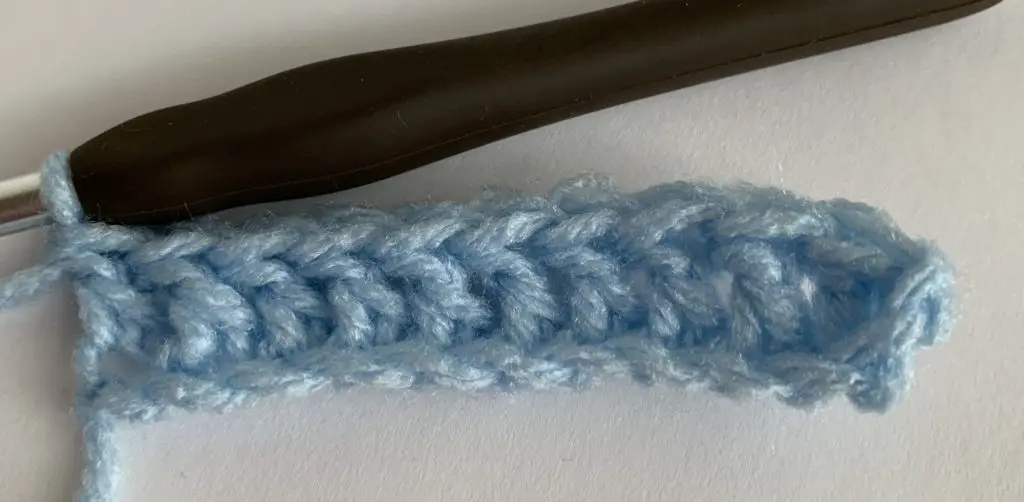Contents
Hello again! In Part 1 of the Beginner Crochet Guide, you began learning some crochet basics, like slip knots, chaining and single crochets. Today, we’re going to cover the remaining major stitches; half-double crochet, double crochet and one not-quite-stitch, the slip stitch.
Half-Double Crochet
First up, is the half-double crochet (hdc). It’s pretty much exactly what its name implies; half-way between a single and a double crochet. Work a chain of 11 (ch 11) and begin working in the second chain from the hook, but this time, yarn over (yo) before you insert your hook into the chain.

The hdc stitch is yo, insert hook into stitch, yo, pull up a loop, yo, pull through three loops on hook.

Continue working this down your foundation chain until the end, when you should have 10 hdc. To turn, you will chain one, then turn your work.

There is a space in this stitch that is similar to the space you worked into for the single crochet and that’s where you will be working again.

Remember, for a hdc, it’s yo, insert hook into stitch, yo, pull up a loop, yo, pull through three loops on hook.
Double Crochet
Next is the double crochet (dc). It begins like the half-double, but has an extra step in the middle. Work another chain, but this time of 12 (ch 12). You will work your first dc into the third chain from the hook.

Begin with a yo, insert into the third chain from the hook, yo and pull up a loop. There should be three loops on your hook.

Yo again and pull through the two loops closest to the end of the hook and you should have two loops remaining on your hook (second to last picture above). Yo again and pull through the two remaining loops (last picture above).

So a dc is yo, insert hook into stitch, yo, pull up a loop, yo, pull through two, yo, pull through two. Continue this down the foundation chain. You should have 10 dc at the end of the row.

This time, you will chain two and then turn your work.
Similar to the stitches before, there is a space near the top, underneath the “v” you can see when viewing from above. This time it’s a little easier to see, just because of the nature of the dc stitch.

You are going to continue working dc into this space down the row until you reach the end where you should have 10 dc. This is a really popular stitch for blankets if you just want a simple stitch without a pattern. It makes for a comfortable blanket without being overly dense, like a single crochet blanket can be.
Video Tutorial
Prefer to learn by watching? Here you go!
Treble Crochet
There is an additional stitch that could be considered a major stitch called the treble crochet. It builds upon the double crochet with an additional yarn over and additional pull through two on the back end.
However, this stitch is not used very often. I’m not quite sure why. It could be that it’s a little cumbersome to work, or maybe it’s that the resulting fabric is quite open.

This stitch would work very well for summer wearables in my opinion, but would not be great for winter objects, blankets, amigurumi or other objects where you would like a tighter stitch.
If you are interested in learning this stitch, the treble crochet (tr) is worked as yo, yo, insert hook into stitch, yo, pull up a loop, yo, pull through two loops, yo, pull through two loops, yo, pull through two loops.
Here is a comparison with single crochet, half-double crochet, and double crochet, all with ten rows, while the treble is 5 rows.

If you are more of a visual learner, you can find a tutorial from Bernat yarns on Youtube:
Fastening Off
So you have reached the end of your project. Congratulations! Now it’s time to fasten off. All you have to do is cut your yarn with a 6-8 inch tail, yo and pull the end all the way through.

Done! Now what to do with all of the ends that you may have? Visit my Finishing Touches post to find out!
There are many other specialty type stitches that you can learn, but they are built off of these basic crochet stitches. That’s why it’s so important to learn these at the beginning of your crochet journey. Now you could make a blanket or scarf in one of three different stitches; or mix them together! Next post, I discuss some techniques you can use to begin making 3-D objects as well as how to add a border to 2-D projects.

